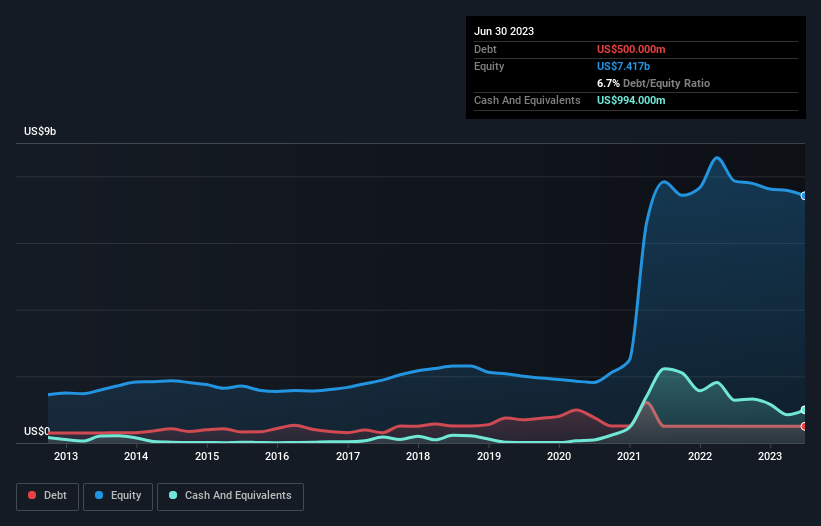- Canada
- /
- Paper and Forestry Products
- /
- TSX:WFG
These 4 Measures Indicate That West Fraser Timber (TSE:WFG) Is Using Debt Reasonably Well
Warren Buffett famously said, 'Volatility is far from synonymous with risk.' It's only natural to consider a company's balance sheet when you examine how risky it is, since debt is often involved when a business collapses. As with many other companies West Fraser Timber Co. Ltd. (TSE:WFG) makes use of debt. But the more important question is: how much risk is that debt creating?
When Is Debt A Problem?
Debt is a tool to help businesses grow, but if a business is incapable of paying off its lenders, then it exists at their mercy. Part and parcel of capitalism is the process of 'creative destruction' where failed businesses are mercilessly liquidated by their bankers. However, a more common (but still painful) scenario is that it has to raise new equity capital at a low price, thus permanently diluting shareholders. Having said that, the most common situation is where a company manages its debt reasonably well - and to its own advantage. The first thing to do when considering how much debt a business uses is to look at its cash and debt together.
View our latest analysis for West Fraser Timber
What Is West Fraser Timber's Net Debt?
The chart below, which you can click on for greater detail, shows that West Fraser Timber had US$500.0m in debt in June 2023; about the same as the year before. However, its balance sheet shows it holds US$994.0m in cash, so it actually has US$494.0m net cash.

How Healthy Is West Fraser Timber's Balance Sheet?
We can see from the most recent balance sheet that West Fraser Timber had liabilities of US$725.0m falling due within a year, and liabilities of US$1.57b due beyond that. Offsetting this, it had US$994.0m in cash and US$569.0m in receivables that were due within 12 months. So it has liabilities totalling US$736.0m more than its cash and near-term receivables, combined.
Of course, West Fraser Timber has a market capitalization of US$6.60b, so these liabilities are probably manageable. But there are sufficient liabilities that we would certainly recommend shareholders continue to monitor the balance sheet, going forward. Despite its noteworthy liabilities, West Fraser Timber boasts net cash, so it's fair to say it does not have a heavy debt load!
It is just as well that West Fraser Timber's load is not too heavy, because its EBIT was down 99% over the last year. When it comes to paying off debt, falling earnings are no more useful than sugary sodas are for your health. There's no doubt that we learn most about debt from the balance sheet. But ultimately the future profitability of the business will decide if West Fraser Timber can strengthen its balance sheet over time. So if you want to see what the professionals think, you might find this free report on analyst profit forecasts to be interesting.
Finally, a business needs free cash flow to pay off debt; accounting profits just don't cut it. While West Fraser Timber has net cash on its balance sheet, it's still worth taking a look at its ability to convert earnings before interest and tax (EBIT) to free cash flow, to help us understand how quickly it is building (or eroding) that cash balance. Over the most recent three years, West Fraser Timber recorded free cash flow worth 72% of its EBIT, which is around normal, given free cash flow excludes interest and tax. This free cash flow puts the company in a good position to pay down debt, when appropriate.
Summing Up
Although West Fraser Timber's balance sheet isn't particularly strong, due to the total liabilities, it is clearly positive to see that it has net cash of US$494.0m. The cherry on top was that in converted 72% of that EBIT to free cash flow, bringing in US$152m. So we are not troubled with West Fraser Timber's debt use. While West Fraser Timber didn't make a statutory profit in the last year, its positive EBIT suggests that profitability might not be far away. Click here to see if its earnings are heading in the right direction, over the medium term.
If, after all that, you're more interested in a fast growing company with a rock-solid balance sheet, then check out our list of net cash growth stocks without delay.
Valuation is complex, but we're here to simplify it.
Discover if West Fraser Timber might be undervalued or overvalued with our detailed analysis, featuring fair value estimates, potential risks, dividends, insider trades, and its financial condition.
Access Free AnalysisHave feedback on this article? Concerned about the content? Get in touch with us directly. Alternatively, email editorial-team (at) simplywallst.com.
This article by Simply Wall St is general in nature. We provide commentary based on historical data and analyst forecasts only using an unbiased methodology and our articles are not intended to be financial advice. It does not constitute a recommendation to buy or sell any stock, and does not take account of your objectives, or your financial situation. We aim to bring you long-term focused analysis driven by fundamental data. Note that our analysis may not factor in the latest price-sensitive company announcements or qualitative material. Simply Wall St has no position in any stocks mentioned.
About TSX:WFG
West Fraser Timber
A diversified wood products company, engages in manufacturing, selling, marketing, and distributing lumber, engineered wood products, pulp, newsprint, wood chips, and other residuals and renewable energy.
Excellent balance sheet and good value.
Similar Companies
Market Insights
Community Narratives




